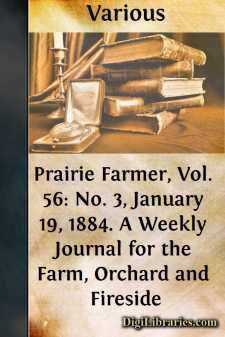Categories
- Antiques & Collectibles 13
- Architecture 36
- Art 48
- Bibles 22
- Biography & Autobiography 813
- Body, Mind & Spirit 142
- Business & Economics 28
- Children's Books 15
- Children's Fiction 12
- Computers 4
- Cooking 94
- Crafts & Hobbies 4
- Drama 346
- Education 46
- Family & Relationships 57
- Fiction 11828
- Games 19
- Gardening 17
- Health & Fitness 34
- History 1377
- House & Home 1
- Humor 147
- Juvenile Fiction 1873
- Juvenile Nonfiction 202
- Language Arts & Disciplines 88
- Law 16
- Literary Collections 686
- Literary Criticism 179
- Mathematics 13
- Medical 41
- Music 40
- Nature 179
- Non-Classifiable 1768
- Performing Arts 7
- Periodicals 1453
- Philosophy 64
- Photography 2
- Poetry 896
- Political Science 203
- Psychology 42
- Reference 154
- Religion 513
- Science 126
- Self-Help 84
- Social Science 81
- Sports & Recreation 34
- Study Aids 3
- Technology & Engineering 59
- Transportation 23
- Travel 463
- True Crime 29
Prairie Farmer, Vol. 56: No. 3, January 19, 1884. A Weekly Journal for the Farm, Orchard and Fireside
by: Various
Categories:
Description:
Excerpt
Editor Prairie Farmer—I write you in regard to the corn question. I would like to know if angle-worms damage corn.
Eight years ago I came to the conclusion that I could raise double the number of bushels of corn that I was then raising. I then commenced experimenting on a small scale. I succeeded very well for the first three or four years. I got so that I could raise over ninety bushels per acre. In one year I got a few pounds over 100 bushels per acre. Three years ago my crop began to fail, and has continued to fail up to the present year, with the same treatment. Last year it was so bad that I concluded to examine the roots of the corn plants. I found both angle-worms and grubs in the roots. This year I went into a thorough examination and found nothing there but angle-worms, with a wonderful increase. They were right at the end of the stalk where the roots were thick, but the worms thicker.
The corn at first seems to do very well, but long before the grain gets ripe the leaves begin to get dry and the stalks commence falling. The consequence is that over one-half the corn is loose on the cob and the ears very short. I am entirely headed in the corn line. Is it the angle-worms? If so, what is the remedy? I plant my corn every year on the same ground. I allow no weeds to grow in my cornfield. Farmers can not afford to raise weeds. I remove all weeds and put corn in their places.
I have plowed my land for the next year's crop of corn and put on twenty loads of manure to the acre and plowed it under. I have no faith in planting the ground next year unless I can destroy the worms that I call angle-worms. I have consulted several of my brother farmers, and they say that the angle-worms never destroy a crop of corn.
I thought last year that my seed corn was poor and run out, so I went to Chicago and got Sibley's "Pride of the North," but that was no better.
If you will kindly inform me how to remedy this looseness of the kernel I will agree to show you how 100 bushels of corn can be raised on one acre every good corn year.
Horace Hopkins.
Desplaines, Ill., Jan. 2.
We sent this communication to Professor Forbes, State Entomologist and received the following reply:
Editor Prairie Farmer—There can be hardly a shadow of a doubt that the injury which your correspondent so graphically describes is due to the corn root-worm (Diabrotica longicornis), a full account of which will be found in my report for 1882, published last November.
The clue to his whole difficulty lies in the sentence, "I plant my corn every year on the same ground." As the beetles from which the root-worms descend lay their eggs in corn fields in autumn, and as these eggs do not hatch until after corn planting in the following spring, a simple change of crops for a single year, inevitably starves the entire generation to death in the ground.
I inclose a slip, giving a brief account of this most grievous pest; but the article in my last report already referred to will be found more satisfactory.
S. A. Forbes....






















